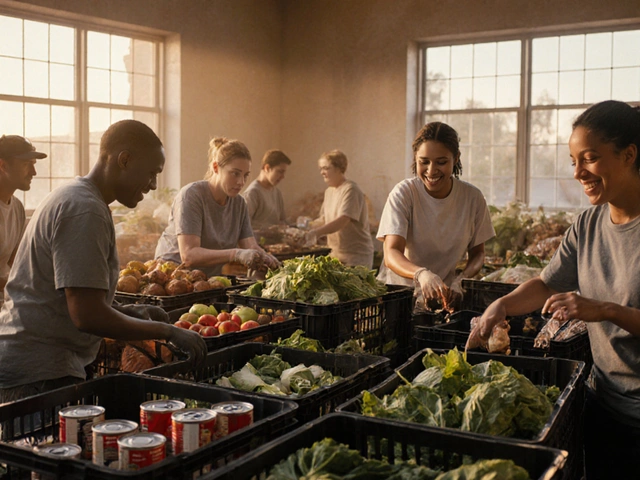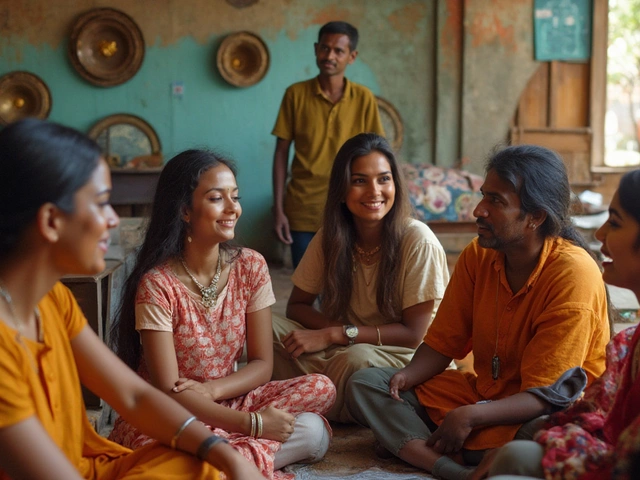Choosing a volunteer isn’t just about who shows up first or who sends the best email. There’s more riding on this than you think—poor matches can slow things down, mess up team spirit, or even chase away good people. It’s worth taking a beat to figure out who’s actually right for the job, not just who says they’re excited.
Start by asking yourself what the role really needs. Do you want someone who’s patient with kids, or is this a gig where organization skills matter most? The clearer you are, the less likely you’ll end up with someone out of their depth or bored out of their mind. If you haven’t already, jot down the must-haves and nice-to-haves for the position. You’d be surprised how many folks skip this step and regret it later.
- Why Picking the Right Volunteer Matters
- What to Look For: Skills and Personality
- Screening Your Candidates
- Interview Tips You’ll Actually Use
- Making the Final Choice: No Regrets
- Setting Up for Success
Why Picking the Right Volunteer Matters
It might sound dramatic, but the volunteer you bring on board can totally change how everything goes. When you choose a volunteer who actually fits, projects run smoother, people get along better, and everyone leaves happier. It’s not just feel-good talk—there’s actual proof. The Corporation for National and Community Service found that organizations with volunteers matched well to roles report a 29% boost in overall productivity compared to those who just fill in spots randomly.
If you’re running anything with kids, older adults, or sensitive tasks, the stakes shoot up even more. The wrong person can mean messed up schedules, safety risks, or just awkward vibes for the whole team. On the flip side, the right match makes folks stick around longer. Studies show that about 60% of volunteers quit in their first year if they don’t feel useful or connected.
| Area Affected | Bad Fit | Right Fit |
|---|---|---|
| Team Morale | Low, clashing styles | High, smooth teamwork |
| Retention | High turnover, wasted training | People stay and grow |
| Project Outcome | Missed goals and chaos | More gets done, better quality |
Real talk—trying to fix a bad fit later is way harder than getting it mostly right at the start. Once someone’s on the team, it’s tough to make a change without hurting feelings or slowing down the whole group. So yeah, thinking things through up front actually makes life easier for everyone involved.
What to Look For: Skills and Personality
Think of picking a volunteer like hiring for any other role—the right person needs more than just a smiling photo. Skills count, but personality can be the game-changer. Here’s where people get tripped up: They focus only on a resume or a past volunteer gig, but forget whether the candidate actually fits the group's vibe and the day-to-day reality of the job.
Let’s start with skills. Does your volunteer need to be handy with computers, lead a team, or organize files? Or maybe just know how to talk to people without scaring them away? Make a list of what’s actually needed—not just a wishlist, but what keeps things moving in your group. If you’re not sure, ask people who’ve done the job before. They’ll tell you the real stuff that makes life easier.
- Communication skills: Can they explain things and listen well?
- Reliability: Do they show up on time and follow through?
- Teamwork: Are they okay with taking direction or working with others?
- Tech know-how: For some roles, basic computer or phone skills matter.
- Specific knowledge: For example, experience with kids, seniors, or animals.
But don’t stop at skills. Personality can decide whether someone sticks around or bails as soon as things get tough. Are they flexible when plans change? Willing to learn and admit mistakes? If your team thrives on jokes and teamwork, someone who freezes up in social settings might struggle.
About 60% of nonprofits have reported that getting the right volunteer with the right fit leads to projects getting done faster and fewer issues with morale. That’s no coincidence.
| Role Type | Key Skill | Must-Have Personality Trait |
|---|---|---|
| Event Support | People skills | Adaptability |
| Admin/Remote Work | Attention to detail | Reliability |
| Mentor/Tutor | Subject expertise | Patience |
| Animal Rescue | Animal care knowledge | Calm under pressure |
Don’t ignore those little gut feelings in an interview either. If someone seems arrogant or can’t answer questions about teammates, it’s probably not a fluke. On the flip side, a person who’s eager to learn—even if not perfect on skills—might be a lot more valuable long term. Figure out what matters most for your group, write it down, and use it as your north star when picking your next volunteer.
Screening Your Candidates
When it comes to finding the right fit, screening is your safety net. Rushing this part just opens the door for problems down the line. Start simple: always check the info your candidate gave you. Did the email match the name? Was the phone number real? Double-checking basic details nips scams in the bud fast.
If you’re looking for someone who will be working with vulnerable groups, like kids or elderly folks, background checks aren’t just smart—they’re often the law. In the U.S., the National Center for Victims of Crime found that more than 70% of nonprofits reported using background checks for at least some volunteers in 2023. It’s not about being suspicious; it’s about keeping everyone safe.
References are gold. You’d be surprised how many folks skip this step. Send a quick email or make a call to at least two of the names your candidate provides. Ask direct questions like, "Would you trust this person with a room full of strangers?" or "Would you pick them again for a similar project?" If someone hesitates, that’s worth paying attention to.
- Look for gaps or weird overlaps on their experience. If things don’t add up, ask why.
- Google their name. Social media can reveal attitude and work ethic.
- If the role is skill-specific, have them show you—ask for a quick sample or do a trial task.
"Thorough screening is not about distrust—it's about protecting the people you serve and making sure your mission succeeds." – VolunteerMatch.org
These steps may feel like extra work, but they save you headaches later. Want some real numbers? Check out this table based on a 2024 survey from VolunteerHub about common screening practices:
| Screening Method | Percentage of Orgs Using |
|---|---|
| Background Checks | 76% |
| Reference Checks | 81% |
| Skills Assessment | 63% |
| Trial Tasks | 42% |
The takeaway: screen every choose a volunteer process like it actually matters—because it does. You’ll sleep better, your project will run smoother, and your team will thank you for it.

Interview Tips You’ll Actually Use
The interview is where you really get to figure out if someone is the right volunteer for the spot. Forget stuffy, robotic questions—they never get real answers. The goal here is to see if your candidate fits the vibe and can actually do what you need.
First, keep things relaxed. People give better answers when they’re not stressed, and you’ll spot their real personality faster. Start with easy questions about their past volunteer work or what made them apply. If they freeze up or sound rehearsed the whole time, that’s a clue they might not work out in real situations.
The best interviews blend skills questions with stuff about attitude and how they handle basic problems. Try some of these:
- "Can you walk me through how you handled a challenge in another volunteer role?"
- "If you noticed a team member struggling, what would you do?"
- "What’s something that frustrates you? How do you deal with it?"
- "On a scale from 1–10, how comfortable are you doing [key task for the role]?"
It’s not just about the answers, but how open, honest, and upbeat they are. Listen for specifics—if every story is about "helping people" but with zero details, watch out.
Don’t forget to lay out expectations. Talk about times, tasks, even the boring stuff like paperwork and background checks. See if they hesitate or start backpedaling. If so, better to know now than two weeks in.
Bring someone else from your team into the interview if you can. A second opinion is gold—sometimes you’re too close to spot a bad fit. Plus, teamwork starts now, not after someone joins.
If you want data to back this up, check this out. Programs that screen and interview their volunteers report much lower dropout rates, according to the National Council for Nonprofits:
| With Interview Process | Without Interview Process |
|---|---|
| 15% dropout rate | 37% dropout rate |
Bottom line: ask questions that matter, set the right mood, and look past the scripted answers. You’re not just filling a slot—you’re building a reliable team.
Making the Final Choice: No Regrets
Alright, it’s crunch time. You’ve met your candidates, maybe done a few interviews or trial runs. Now how do you really nail it and choose a volunteer who won’t have you second-guessing yourself in a month?
Start by stacking up what each person brings to the table against what you actually need. Look at hard skills and track record, but don’t sweep attitude or flexibility under the rug. Some of the best volunteers aren’t always the ones with the fanciest resumes—they’re the ones who really want to be there, show up on time, and treat people well. A 2023 report from VolunteerMatch pointed out that nearly 75% of successful placements happened when organizations picked for personality and fit, not just skills.
If you’re split between a few people, set up a quick trial shift. Watch how they handle pressure and teamwork. You’ll get more from seeing someone in action for an hour than from reading their application five times. If your gut says something’s off, listen. It’s not magic—sometimes there are little red flags, like someone constantly asking about perks, or turning up late, even just for chats. Those small things add up once the work starts.
- Double-check their references. Don’t just call—ask specific questions like, “Would you want to work with them again?”
- If you’re still stuck, get a second opinion from another team member or leader.
- Don’t drag out your decision. Good volunteers don’t hang around forever waiting for a call. Be direct—yes or no, and let them know quickly.
At the end of the day, you’re looking for someone who’s pumped for the cause and ready to do the work. If you’re clear on what you want, trust your process, and make the call, you’re way more likely to land a volunteer who’ll make life easier—not harder.
Setting Up for Success
So, you picked someone—you’re not done yet. The way you welcome and support a new volunteer totally shapes how well things go, and whether they stick around. More than 40% of volunteers drop out after their first experience if they feel lost or unappreciated. That’s a scary stat, but it’s easy to dodge by setting things up right from the start.
Here’s what works in real life:
- Orientation matters: Don’t just toss a volunteer into the deep end. Even a quick walk-through of what’s expected, who to go to with questions, and how things work can make a huge difference. Set aside time for this, even if everyone’s busy.
- Create a cheat sheet: No one likes guessing where the bathroom is, who handles supplies, or what to do if something goes wrong. Put the basics in writing. Email it before day one, or hand it out when they arrive.
- Introduce them: Show your new volunteer who’s on their team. Even a short group chat or a couple of intro emails helps people remember names and feel included.
- Give simple first tasks: Don’t start them off with a mountain of work. Let them nail some easy wins. This builds confidence and makes them want to come back—seriously, huge difference.
- Check in, but don’t hover: Ask how it’s going after that first shift. Small problems snowball fast if nobody’s available to talk to. But don’t micromanage, either; it feels weird for everyone.
One thing people forget: Recognize effort, not just results. A quick thank you or public shout-out goes way further than you’d think. When you put in the work to set volunteers up for success, you’re way more likely to hold onto the good ones—and others will want to join too. That’s the heart of choosing a volunteer who actually sticks.





